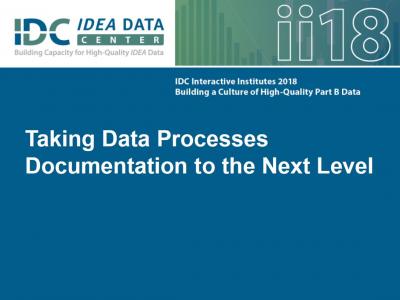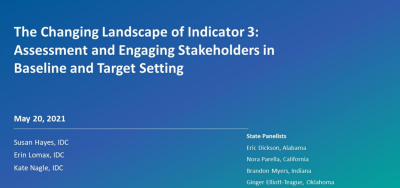Site Search
Results 8 - 13 of 13
-
Norms of Collaboration: Strategies for Working Together Effectively in Person and Virtually
Following the norms of collaboration for working in groups can help groups accomplish their goals more effectively. Attending to the norms of collaboration takes on even greater importance as, more than ever, group members are working together in virtual environments. Norms of collaboration include behaviors such as pausing, paraphrasing, putting inquiry at the center, probing for specificity, putting ideas on the table, paying attention to self and others and presuming positive intentions. This IDC professional development experience helped attendees learn more about the norms of collaboration; how they can contribute to positive, productive group dynamics; and ways to apply the norms when working both in-person and virtually with others.
-
The Changing Landscape of Indicator 3: Assessment and Engaging Stakeholders in Baseline and Target Setting
During this webinar, we reviewed the changes to Indicator 3 of the Part B SPP/APR and took a deep dive into how some states are preparing and working with stakeholders to set baselines and targets for the indicator. State panelists addressed data quality concerns due to COVID-19 closures and reopenings, as well as the 2021 testing flexibilities and how they affect setting baselines and targets. Speakers presented strategies for identifying diverse stakeholders and presenting complex data to help stakeholders understand the data. In addition, state panelists revealed their plans for working with stakeholders, including the data they plan to share with stakeholders, how they plan to present these data, what input they will ask for, and how they plan to document ongoing stakeholder input.
-
Including Results Data in General Supervision Systems
This IDEA Data Center (IDC) and National Center for Systemic Improvement (NCSI) joint webinar focused on learning from states that are working to meaningfully include student results or outcomes data in their general supervision systems. Presenters shared “lessons learned” from state work, including both important considerations for states that are in the planning stages, as well as for those actively engaged in centering results data in their accountability and support systems. Participants also heard how states can integrate data use as part of their general supervision system.
Format: Presentations
Taking Data Processes Documentation to the Next LevelThis workshop provided participants an opportunity to envision and begin development of a comprehensive plan for creating protocols and follow-up activities they may use at both the SEA and LEA levels. Session activities focused on identifying appropriate roles to be represented at the table. They also focused on methods for engaging staff in the work and other critical considerations for implementing and sustaining these foundational data practices.
Format: Quick Reference
Navigating Uncharted Waters: Engaging Stakeholders in Part B Indicator 3 Baseline and Target SettingThis customizable resource includes a PowerPoint template and presentation notes that provide states with an overview of the Part B SPP/APR reporting changes to Indicator 3, which addresses participation and performance of children with individualize education programs (IEPs) on statewide assessments. The resource reviews the new requirements related to stakeholders, particularly parents, in the SPP/APR and implications for Indicator 3 and shares strategies for engaging stakeholders in the optional baseline and required target setting processes. States are able to customize the information in the PowerPoint to reflect their own contexts and to meet the needs of different audiences.
Format: Guides and Briefs
Unpacking and Understanding Part B SPP/APR Indicator 3DThe purpose of this resource is to unpack Part B SPP/APR Indicator 3D to better understand how to use Indicator 3D results to improve outcomes for all children with IEPs. This resource guides the reader through Indicator 3D, including how to calculate it; information on the setting/resetting of its baselines and targets; and considerations when analyzing, reporting, and using Indicator 3D data. As an aid to deepen learning, this resource includes examples with fictitious data.







